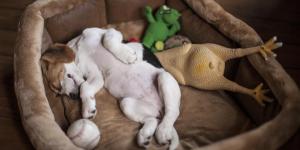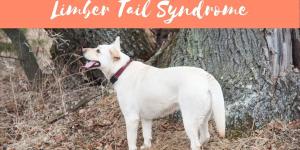My Dog Is Limping After Sleeping



See files for Dogs
If a dog starts limping when they wake up, it can be easy to think they are merely stiff from rest. While this can be the case, especially with older dogs, it doesn't mean we should think a dog limping after sleeping is normal. On the contrary, it can be a sign of various ailments and illnesses, particularly those that affect joints and the musculoskeletal system in general. Age is not an unimportant factor since joint stiffness is inevitable when dogs reach a certain age. If it happens in younger dogs, early intervention is particularly important as it can help slow degeneration.
At AnimalWised, we investigate why my dog is limping after sleeping. We look at conditions which can cause lameness on both the front and back legs of the dog, as well as what we can do to improve the animal's quality of life.
Arthritis
Arthritis in dogs consists of inflammation of the joints, specifically of the articular cartilage and the synovial membrane. Both a dogs forelimbs and hindlimbs can be affected by arthritis. Depending on its etiology, arthritis can present in one of the following ways:
- Infectious arthritis: when there are infectious agents involved, usually bacterial. These types of arthritis in dogs are known as an arthropathy. They may be linked to sepsis or be reactive to another infection in the body.
- Non-infectious arthritis: when joint damage is caused by non-infectious processes. These include the development of immune disorders which can be the result of immune-mediated diseases, chronic inflammations or neoplasms, among others. Degenerative joint diseases are common health problems in older dogs.
Regardless of its origin, arthritis usually causes joint pain and lameness. It is common for lameness to worsen after prolonged periods of rest, meaning we a dog is limping after sleeping. Changes in weather can also increase stiffness due to the cold acting on their joints.
The treatment of this process will depend on the specific type of arthritis that affects the animal. In general, infectious arthritis is treated with antibiotics and joint lavages. Non-infectious arthritis that are a result of immune-mediated processes are usually treated with immunomodulatory drugs.
Once a certain level of arthritis has developed, the lameness will not be reversed, but degeneration can be slowed and symptoms managed. For this reason, the veterinarian will likely combine specific drug therapies with other coadjuvant treatments such as analgesics, chondroprotectors, nutraceuticals or physiotherapy for dogs with arthritis.
Primary osteoarthritis
Although it is a type of arthritis in dogs, osteoarthritis is such a common reason a dog is limping after sleeping that we want to look at it in greater individual detail. Also known a degenerative joint disease, osteoarthritis is a chronic joint disease characterized by the breakdown and loss of articular cartilage. It is followed by the formation of new bone around the joint. As it progresses, it is common for clinical signs such as joint pain and limping to appear.
Osteoarthritis in dogs can have a primary or secondary origin. It can affect the front and back legs equally, although this will often depend on the activities of the specific dog. Primary osteoarthritis usually affects older animals and appears as a consequence of normal aging of the joints.
Its treatment can be approached from different ways. In the case of primary osteoarthritis, a conservative treatment is usually chosen based on the following points:
- Weight control: excess fat favors the formation of inflammatory mediators that perpetuate the inflammatory process. In addition, excess body weight produces an additional overload on the joints of both front and back legs, worsening the degenerative process. For this reason, weight control is one of the most important aspects in the treatment of osteoarthritis.
- Regular, moderate physical activity: some guardians may think that exercise will either be impossible or worsen the dog's osteoarthritis. While high-impact activities, such as running and jumping, and strenuous walks should be avoided, light to moderate exercise will help with their symptoms. This is because it will strengthen the muscles that surround the joints to provide support and stability.
- Pain management: it can be addressed with non-steroidal anti-inflammatory drugs, as well as other analgesics such as gabapentin, tramadol, etc.
- Chondroprotectors: chondroitin sulfate, glucosamine, and omega-3 fatty acid supplements are most often recommended.
- Rehabilitation: including physiotherapy, hydrotherapy and others to help improve joint mobility and increase muscle mass.
Secondary osteoarthritis
As we have seen in the previous section, osteoarthritis can have a primary cause. Osteoarthritis in dogs often appears secondary to other orthopedic diseases. These cause instability and result in the dog limping after sleeping. We look at some of the main pathologies that can lead to the development of osteoarthritis in dogs.
Hip dysplasia
It is a very common hereditary pathology in large and giant dogs. It occurs as a consequence of the abnormal development of the hip joint, resulting in a dislocation or subluxation of the joint. Since the hip is where the pelvic joints are located, hip dysplasia only affects the back legs of the dog.
The evolution of the disease causes lesions on the joint surfaces which become chronic and result in joint degenerative disease. For this reason, it is common to observe a limp in the posterior third during advanced stages of the disease, which can improve slightly with appropriate exercise.
The resolution of hip dysplasia is surgical intervention. A wide variety of surgical techniques have been described, the purpose of which are to treat pain and restore locomotor functionality of the hip joint. These techniques are divided into three groups, depending on their purpose:
- Preventive techniques: prevent or delay the development of degenerative joint disease such as symphysiodesis, triple pelvic osteotomy or double pelvic osteotomy.
- Curative techniques: solve the progression of the disease and radically eliminate pain. Includes arthroplasty or the placement of a hip prosthesis.
- Palliative techniques: reduce pain without eliminating joint damage, such as denervation of the joint capsule.
Dogs with hip dysplasia should never be used for breeding, as it is a hereditary disease. It is a common disease of German Shepherds and can be seen in their hind legs becoming bent as a result. Carrying out responsible breeding is also crucial in order not to perpetuate hereditary pathologies and respect the five basic freedoms of animal welfare.

Avascular necrosis of the femoral head in advanced stages
It is a developmental disease that affects young dogs, especially small dog breeds. In these animals there is an interruption of the blood supply to the head and neck of the femur. This produces bone necrosis and will eventually cause the dog to limit their movement. Pain after being at rest is common, often resulting in the dog limping after sleeping.
It does not initially produce clinical symptoms, but clinical signs such as lameness and intense pain at the femoral head appear over time. In advanced stages of the disease, osteoarthritis occurs in the hip joint. This means the back legs can be more affected.
Surgical treatment of avascular necrosis is necessary and consists of performing a complete resection of the head and neck of the femur. The success rate of this treatment is very high. A long period of rest is not necessary and the final recovery is considerably fast.
Poorly treated joint pathologies
Almost any joint disease that has not been properly treated will eventually cause a degenerative process in the joint of the front or back legs of a dog. Some of the most frequent examples are the following:
- Anterior cruciate ligament rupture: after the rupture, the ligament does not regenerate nor can it be replaced, so it is necessary to perform a surgical technique that replaces the fixation in the knee. In this way, joint instability will be corrected and the appearance of degenerative joint disease will be prevented.
- Articular fractures: are those that affect any of the bone ends that make up a joint. All joint fractures must be surgically reduced with the greatest possible precision, otherwise an incongruity will be generated in the joint that in the long term will favor the development of osteoarthritis.
- Patella fractures: whether they are transverse, longitudinal or comminuted fractures, they need surgical treatment to avoid the development of osteoarthritis.
We have discussed what happens when a dog is limping after sleeping, but sometimes symptoms of pathologies can occur while they are at rest. Learn more with our article on why a dog is shaking while sleeping.

This article is purely informative. AnimalWised does not have the authority to prescribe any veterinary treatment or create a diagnosis. We invite you to take your pet to the veterinarian if they are suffering from any condition or pain.
If you want to read similar articles to My Dog Is Limping After Sleeping, we recommend you visit our Other health problems category.






